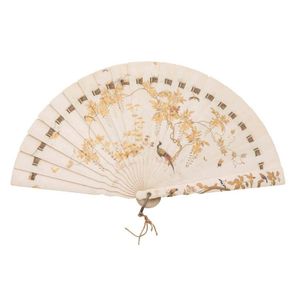19th Century Garnet and Emerald Lady's Dress Ring
You must be a subscriber, and be logged in to view price and dealer details.
Subscribe Now to view actual auction price for this item
When you subscribe, you have the option of setting the currency in which to display prices to $Au, $US, $NZ or Stg.
- Emeralds - Emeralds have been used in jewellery making for thousands of years, and are prized for their deep green colour, which is caused by the presence of chromium and vanadium in the mineral beryl. Because of their rare colour, emeralds are often more valuable than diamonds of a similar size and quality. In jewellery making, emeralds are typically cut into round or oval shapes to maximize their color and clarity. They are often set in gold or platinum and used as the centrepiece of a piece of jewellery, such as a ring or necklace. They can also be used in combination with other gems, such as diamonds, to create intricate and beautiful designs.
- Garnet - A garnet is a mineral that is commonly used as a gemstone. It occurs in a wide range of colours, including red, pink, orange, green, yellow, and black. The most common and best known type of garnet is the red variety, which has a deep, rich colour and is often referred to as a "garnet red."
Garnets have a long history of use as gemstones, and they have been prized for their beauty and durability for thousands of years. They are often used in jewellery, such as rings, necklaces, and earrings, and they are also sometimes used as a decorative element in other items, such as vases and goblets.
Garnets are prized for their brilliance, durability, and resistance to scratching, making them a popular choice for use in jewellery. They are also valued for their hardness, which makes them well suited for use in abrasive applications, such as sandpaper and grinding wheels. - Faceting - Faceting is a technique of removing material from a curved surface, to give a series of flat surfaces but retaining the profile of the original surface.
The technique is most commonly associated with diamond cutting where the various cuts used such as rose cut and brilliant cut, add life and sparkle to the stone, whilst at the same time removing as little of the stone as possible.
Faceting by grinding is also used to decorate glass. The stems of many drinking glasses are decorated by cutting a series of flat surfaces on a circular stem, and hollow vessels such as vases may have faceted surfaces.
In furniture faceting is often applied to legs of tables and chairs, where a circular baluster shaped section is flattened so as to form an octagonal section.
This item has been included into following indexes:
Visually similar items

A Japanese Shibiyama ivory and gilt fan, Meiji period, open 28 cm high, 50 cm wide

Tudor lady's vintage wristwatch, round dial marked Tudor Rolex watch Co. Ltd, with Arabic numerals, subsidiary seconds on a Tudor 17 jewel movement signed Fhf 30, Handley case back no. 135599, metal band, working.

A fine mahogany and marble Louis XVI bedside table, later 19th century, the oval table with a mottled beige inset marble top, a small single drawer with a recessed panel above a conforming white porcelain lined cupboard, and raised upon long slender and ta

A 9ct gold sweetheart locket brooch, worked with the 33rd New Zealand Reinforcements insignia, opening to reveal two photographs. Total 15.2gms.
